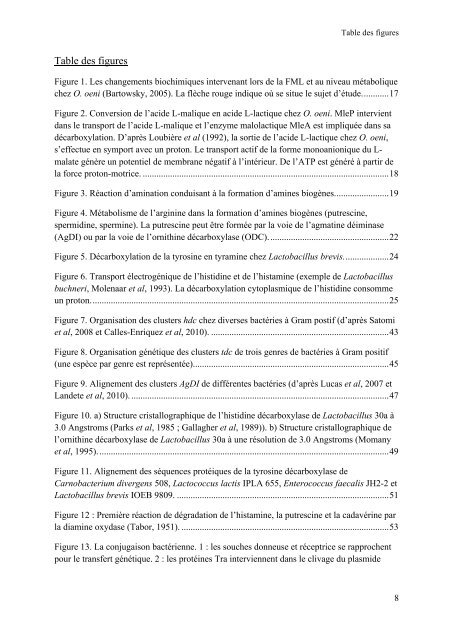THESE Maryse Bonnin Jusserand - Université de Bourgogne
THESE Maryse Bonnin Jusserand - Université de Bourgogne
THESE Maryse Bonnin Jusserand - Université de Bourgogne
Create successful ePaper yourself
Turn your PDF publications into a flip-book with our unique Google optimized e-Paper software.
Table <strong>de</strong>s figures<br />
Table <strong>de</strong>s figures<br />
Figure 1. Les changements biochimiques intervenant lors <strong>de</strong> la FML et au niveau métabolique<br />
chez O. oeni (Bartowsky, 2005). La flèche rouge indique où se situe le sujet d’étu<strong>de</strong>. ........... 17<br />
Figure 2. Conversion <strong>de</strong> l’aci<strong>de</strong> L-malique en aci<strong>de</strong> L-lactique chez O. oeni. MleP intervient<br />
dans le transport <strong>de</strong> l’aci<strong>de</strong> L-malique et l’enzyme malolactique MleA est impliquée dans sa<br />
décarboxylation. D’après Loubière et al (1992), la sortie <strong>de</strong> l’aci<strong>de</strong> L-lactique chez O. oeni,<br />
s’effectue en symport avec un proton. Le transport actif <strong>de</strong> la forme monoanionique du Lmalate<br />
génère un potentiel <strong>de</strong> membrane négatif à l’intérieur. De l’ATP est généré à partir <strong>de</strong><br />
la force proton-motrice. ............................................................................................................ 18<br />
Figure 3. Réaction d’amination conduisant à la formation d’amines biogènes. ....................... 19<br />
Figure 4. Métabolisme <strong>de</strong> l’arginine dans la formation d’amines biogènes (putrescine,<br />
spermidine, spermine). La putrescine peut être formée par la voie <strong>de</strong> l’agmatine déiminase<br />
(AgDI) ou par la voie <strong>de</strong> l’ornithine décarboxylase (ODC). .................................................... 22<br />
Figure 5. Décarboxylation <strong>de</strong> la tyrosine en tyramine chez Lactobacillus brevis. ................... 24<br />
Figure 6. Transport électrogénique <strong>de</strong> l’histidine et <strong>de</strong> l’histamine (exemple <strong>de</strong> Lactobacillus<br />
buchneri, Molenaar et al, 1993). La décarboxylation cytoplasmique <strong>de</strong> l’histidine consomme<br />
un proton. .................................................................................................................................. 25<br />
Figure 7. Organisation <strong>de</strong>s clusters hdc chez diverses bactéries à Gram postif (d’après Satomi<br />
et al, 2008 et Calles-Enriquez et al, 2010). .............................................................................. 43<br />
Figure 8. Organisation génétique <strong>de</strong>s clusters tdc <strong>de</strong> trois genres <strong>de</strong> bactéries à Gram positif<br />
(une espèce par genre est représentée). ..................................................................................... 45<br />
Figure 9. Alignement <strong>de</strong>s clusters AgDI <strong>de</strong> différentes bactéries (d’après Lucas et al, 2007 et<br />
Lan<strong>de</strong>te et al, 2010). ................................................................................................................. 47<br />
Figure 10. a) Structure cristallographique <strong>de</strong> l’histidine décarboxylase <strong>de</strong> Lactobacillus 30a à<br />
3.0 Angstroms (Parks et al, 1985 ; Gallagher et al, 1989)). b) Structure cristallographique <strong>de</strong><br />
l’ornithine décarboxylase <strong>de</strong> Lactobacillus 30a à une résolution <strong>de</strong> 3.0 Angstroms (Momany<br />
et al, 1995). ............................................................................................................................... 49<br />
Figure 11. Alignement <strong>de</strong>s séquences protéiques <strong>de</strong> la tyrosine décarboxylase <strong>de</strong><br />
Carnobacterium divergens 508, Lactococcus lactis IPLA 655, Enterococcus faecalis JH2-2 et<br />
Lactobacillus brevis IOEB 9809. ............................................................................................. 51<br />
Figure 12 : Première réaction <strong>de</strong> dégradation <strong>de</strong> l’histamine, la putrescine et la cadavérine par<br />
la diamine oxydase (Tabor, 1951). ........................................................................................... 53<br />
Figure 13. La conjugaison bactérienne. 1 : les souches donneuse et réceptrice se rapprochent<br />
pour le transfert génétique. 2 : les protéines Tra interviennent dans le clivage du plasmi<strong>de</strong><br />
8

















